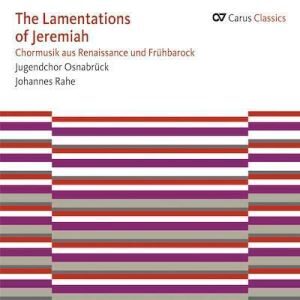There’s a lot of beautiful and well-sung music on this program, a recording from 1986 reissued as part of the Carus label’s “Classics” imprint, a series assembled to mark the company’s 40th anniversary in 2012. The lineup of works seems more like a collection than a designed program, simply presenting, as its title states, “choral music from the Renaissance and late-Baroque”. And while there are some “hits” here–Weelkes’ Hosanna to the son of David; Tallis’ Lamentations of Jeremiah; Gesualdo’s Tenebrae factae sunt; Palestrina’s Stabat Mater dolorosa; Byrd’s Haec dies–there also are lesser-known, or at least lesser-performed gems, especially a couple of the motets by Victoria and Tallis and a disc-closing Regina caeli laetare by 17th-century Catalan composer Joan Cererols.
The enclosed information regarding this very fine choir does not give any clear indication of the actual makeup or meaning of “youth” choir–the best we have is what we are to assume is a photograph of the group, looking down from above onto the tops of the singers’ heads–teenagers? young, or not so young, adults? We can’t be sure, but from the sound, these are young but vocally mature singers who also are experienced in ensemble performance and well-versed in the style of this music. These singers–and their conductor–know how to phrase, how to perfectly balance a quiet dynamic, how to highlight an important line within a busy texture. There are many moments of exquisitely executed high soprano singing as well as delicately lovely expressive gestures by all sections of the choir.
Only one significant misstep mars an otherwise first-rate production: the sluggish, uncertain, intonationally challenged In monte Oliveti by Gesualdo, which inexplicably lies among 13 other finely polished performances, including another, more difficult Gesualdo selection, the Tenebrae factae sunt.
My only previous encounter with this conductor and choir–a 1991 recording of works set to the Biblical Song of Songs on this same label–was seriously compromised by bad sound (read review here). Happily that’s not the case here: everything is clear and the voices are nicely balanced if, in the louder tutti passages, their blend is occasionally threatened with sabotage by the resonant acoustics of the Dom zu Osnabrück, which ultimately isn’t such a bad thing. And for the benefit of the strong ensemble performances and beautiful choral sound, lovers of this repertoire won’t mind at all.
































